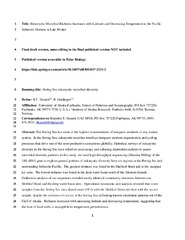Eukaryotic microbial richness increases with latitude and decreasing temperature in the Pacific Subarctic domain in late winter
Permanent link
https://hdl.handle.net/10037/13202Date
2017-06-06Type
Journal articleTidsskriftartikkel
Peer reviewed
Abstract
The Bering Sea has some of the highest concentrations of inorganic nutrients of any marine system. In the Bering Sea, eukaryotic microbes interface inorganic nutrient sequestration and cycling processes that drive one of the most productive ecosystems globally. Historical surveys of eukaryotic microbial diversity in the Bering Sea have relied on microscopy and culturing-dependent analyses to assess microbial diversity patterns. In this study, we used high-throughput sequencing (Illumina MiSeq) of the 18S rRNA gene to explore general patterns of eukaryotic microbial diversity from six regions in the Bering Sea and surrounding Subarctic Pacific. The greatest richness was found in the Shelikof Strait and at the marginal ice zone. The lowest richness was found in the deep water basin south of the Aleutian Islands. Ordination analysis of our sequences revealed nearly identical community structures between our Shelikof Strait and the deep water basin sites. Operational taxonomic unit analysis revealed that water samples from the Bering Sea sites shared more OTUs with the Shelikof Strait site than with the sea ice sample, despite the existence of sea ice in the Bering Sea, reflecting known circulation patterns out of the Gulf of Alaska. Richness increased with increasing latitude and decreasing temperature, suggesting that the base of food webs is susceptible to temperature perturbations.
Description
This is a post-peer-review, pre-copyedit version of an article published in Polar Biology. The final authenticated version is available online at: https://doi.org/10.1007/s00300-017-2131-2 .


 English
English norsk
norsk